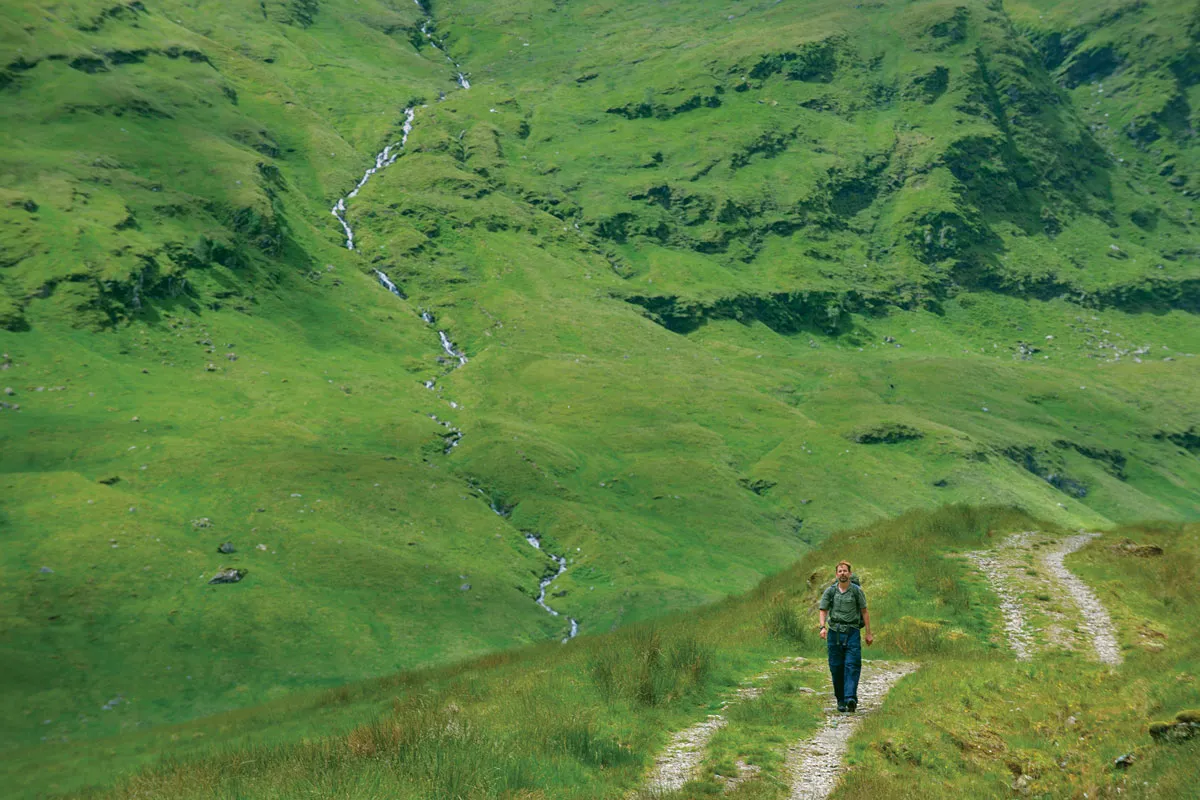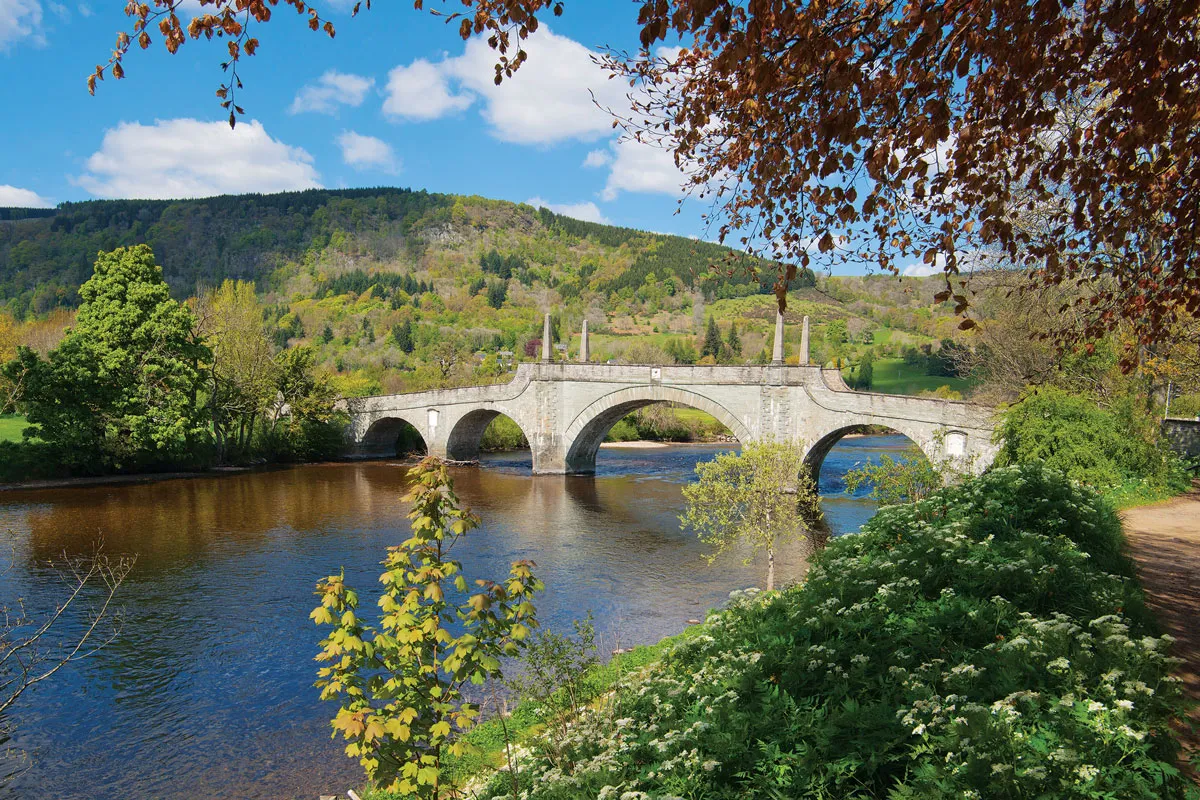So here I am, wading warily through jungles of reeds. My legs are so comprehensively stung by nettles that they’re now hotter than the sunburn on my face. Voracious midges descend on every last inch of unprotected skin. Night is coming and I can’t find anywhere to hang the hammock I’m going to sleep in. And loath though I am to admit it, I’m absolutely loving it.
Unlikely as it sounds, my journey along the length of the River Tay began one afternoon on a small Canadian island. There I had a chance encounter with Tom Hennessy, inventor of the Hennessy Hammock. “Ed Stafford took one of my hammocks with him when he became the first man to walk the length of the Amazon,” Tom told me.

This got me thinking. The Amazon had now been done, but surely I could rustle up an adventure closer to home? After much scouring of maps, my eyes lit upon the Tay, a drunken signature squiggling across the country for
117 miles from the western Grampians to its outflow near Dundee. I resolved to walk Scotland’s longest river in the manner of Stafford’s Amazon odyssey – abiding by the same rules, foraging where possible, sleeping in the same model of hammock and following the river as closely as possible (three cheers for the enlightened Scottish Outdoor Access Code). Three weeks later I’m boarding the sleeper train at Euston bound for Upper Tyndrum, a few miles east of the source.

Walk this tay
According to a 2011 study that relocated the source of the river, the Tay starts life in a high lochan drained by the Allt Coire Laoigh. This feeds the Cononish, which, in turn, supplies the Fillan, which passes through several lochs before the river finally calls itself the Tay. At 680m, on a windblown saddle between Ben Lui and Ben Oss, I duly come upon the nameless lochan – more a glorified puddle, but with a cracking view down a steep narrow glen. I dip my fingers in the water, shoulder my burden, and plunge downhill.
Over the next six days I am treated to a diverse cross-section of central Scotland. The mountains subside with a sigh into hills as I skirt Loch Tay. The Appin of Dull, at the loch’s far end, heralds the first outposts of arable land. Strathtay takes me past Craigvinean Forest, the first of the river’s two substantial woodlands. Gentle farmland gives way to a ghost of the river’s industrial past, the hollowed-out little town of Stanley whose textile mills the Tay powered for over 200 years. Modern urban Scotland is represented by Perth – the self-styled Fair City – and then Dundee, sprawled on the northern shore of the long and languid Firth of Tay.
My modus operandi is to keep to whichever is the wilder side of the river at any given point and I thus become mildly obsessed with bridges. I cross tributaries and streams too numerous to count, and the River Tay itself 11 times, most handsomely at Aberfeldy, where General Wade’s monumental bridge has remained virtually unchanged for nearly three centuries.
As each evening draws on I turn my attention to finding a place to string up my hammock. This is simple early on, where woods and copses abound. However, things become complicated on the shore of the Firth of Tay, scene of the ‘jungles of reeds’ episode. A nearby wood finally solves the problem and I fall asleep to the hoarse protesting barks of unseen deer. Only once do circumstances defeat me, forcing me to check in at Stanley’s one hostelry, the Tayside Hotel. As Ed Stafford allowed himself to accept hospitality, I don’t feel too abashed. But it feels insipid compared with spending the night suspended between trees. At Acharn, I lie listening to thunder rumbling around Loch Tay, echoing off the hillsides and it feels as though I am the one still point in a hurricane of sound.
That may make the trip seem a lonely pursuit but every day I enjoy encounters with (by and large) cheery locals. One very elderly man heaving a bag into his car explains that he is clearing the lochside beach of rubbish. “It’s very satisfying, transforming it from the state it was to the thing of natural beauty it should be,” he tells me behind a quiet smile.
Later, while I’m indulging in a cheeky mid-afternoon pint, a man named Andrew gives me a handy tip: “If the midges start bothering you,” he advises, “get some bog myrtle and rub it in your hands – it’s an old gamekeeper’s trick.”
I should have asked if he had any pointers for spotting the Tay’s otter and beaver populations, both of which elude me. However, I’m treated to a lengthy game of peek-a-boo with a playful red squirrel, and there are buzzards and roe deer aplenty. Oystercatchers, curlews and skylarks fill the skies with their chatter, and sand martins flit busily across the iron-brown Fillan to homes poked in a toffee-coloured riverbank.

Blisters and bliss
At length, I reach Perth. Here the Tay becomes tidal and an impenetrable range of hills pushes it east towards the North Sea. I cross the jarring M90 to find tranquillity again on the south side of the Firth of Tay, a hotspot for ruined abbeys, dog rose and spotted flycatchers. The collapse of the Tay Bridge in 1879, which killed 75 train passengers and crew, will ever cast its shadow across the eastern end of this estuary. The two immense bridges there today appear to be clumsy attempts to draw a finish line at Dundee, but I have not reached the open sea quite yet.
I make my way slowly past Tentsmuir Forest, savouring each moment and keeping my eyes peeled for seals. By the time I reach the wide expanse of sand at Tentsmuir Point, I’ve walked roughly 130 miles in six days, with the blisters to show for it. The Tay pours joyously into the sea, its job done. I tip my hat to it, reach for my hammock, and look forward to a final night of blissful solitude. Across the widening firth, the lights of Broughty, Monifieth and Carnoustie come on one by one, another world away.
The Tay in brief

The Tay is Scotland’s very own Amazon. At 117 miles long, it’s the nation’s longest river and, like its South American counterpart, it begins close to the west coast yet flows into the sea at the east. Both are served by gargantuan river basins – the one that feeds the Tay covers a vast 2,000 square miles, with major tributaries including the Earn, Isla, Tummel and Almond. Straddled at Aberfeldy by the majestic General Wade’s Bridge (pictured), the Tay discharges more water into the sea than the Severn and Thames combined. Like the Amazon, you can pan for gold in it (Leadhills and Tyndrum are popular panning spots).

